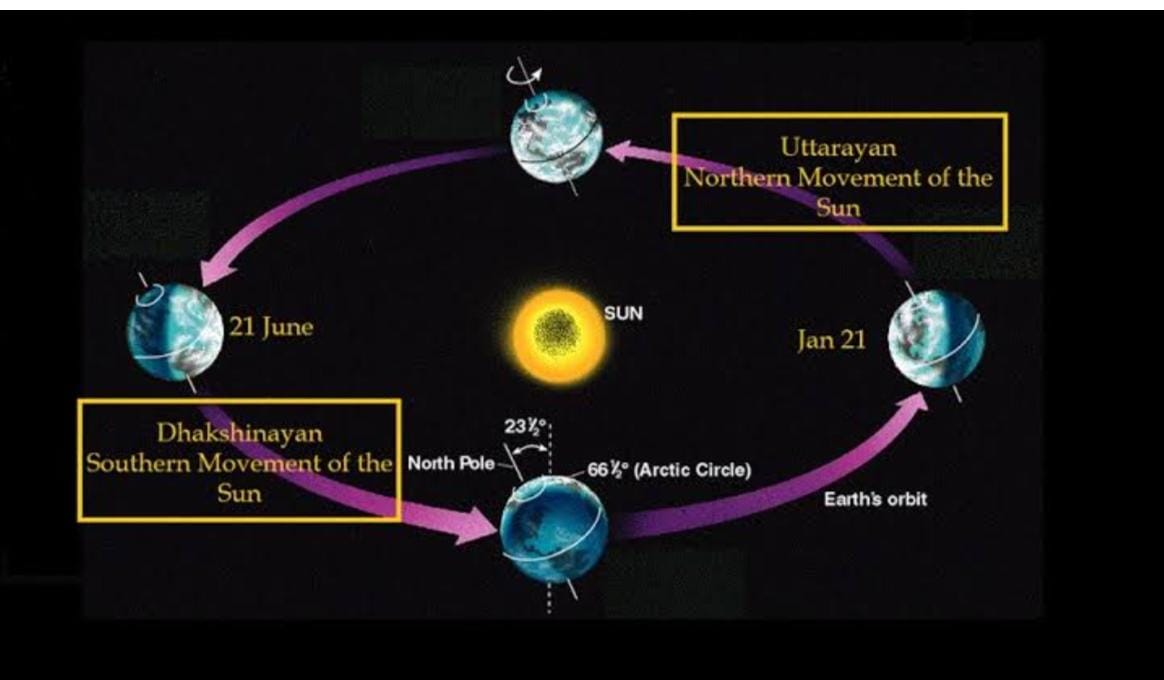Gorakhpur: Maha Kumbh and Makar Sankranti are directly proportional to the movement of celestial bodies and the impact they leave on the earth. Noted astronomer Amrit Pal Singh of Veer Bahadur Singh Planetarium elaborated on the scientific importance behind Sankranti, terming it as an astronomical event.
According to him, the earth's axial rotation leads to seasonal changes as the amount of sunrays in the hemispheres varies due to it. The earth is tilted 23.5 degrees on its axis which impacts days and nights in each hemisphere.
"If we talk about Uttarayan and Dakshinayan (the north and southwards journey of the sun), we find that it is an astronomical event. After January 14 or 15, the sun moves towards the northern hemisphere from the Southern Hemisphere. It is also known as Surya Uttar. For people of the northern hemisphere, it is Makar Sankranti as the sun directly stays on the Tropic of Capricorn," Sing said.
The term Makar Sankranti came into existence based on Makar Mandal. Makar Sankranti means the sun reaching the southern end or northern start point of the ecliptic. Since ancient times, when the sun entered the Makar Mandal and reached this Dakshinayanant or Uttarayanarambh point from the southernmost end of the ecliptic, the day became the shortest (December 21 or 22). Now the sun enters the Makar Mandal in mid-January, the reason is that due to the solstice movement, the Dakshinayanant (or Uttarayanarambh) point has now moved towards the west to the Sagittarius.
The astronomer said the actual Makar Sankranti (Dakshinayanant or Uttarayanarambh point) has nothing to do with the Makar Mandal of the sky. Makar Sankranti marks the transition of the sun into the Tropic of Capricorn, indicating the northward journey. This change happens after the winter solstice when the days start getting longer in the northern hemisphere, ringing in summer. As the sun moves towards the Tropic of Cancer, solar energy increases in the northern hemisphere, which affects the climate, agricultural cycle and biological rhythms. This also encourages rejuvenation and vitality in people of the northern hemisphere, as the sunray is known to be a stable source of vitamin D. During this period, people traditionally bask in the sun or spend more time in the sun which helps the body produce more vitamin D that strengthens bone health and immunity.

The consumption of sesame and jaggery is not only cultural, but these foods are rich in nutrients that help keep the body warm and energetic during winter.
"If we look at Maha Kumbh and its inherent scientific basis, then we find that this ancient festival is also based on astronomical alignment. The International Astronomical Union recognises eight planets in the solar system according to their distance from the sun. They are Mercury, Venus, Earth, Mars, Jupiter, Saturn, Uranus and Neptune. The largest planet among them is Jupiter, which is also called Guru. Ancient civilizations also recognised five planets and Jupiter was also one of them. Even today, if you gaze at the nocturnal sky, five planets can be easily recognised by the naked eye. Jupiter, the brightest body after Venus, is made up of about 75 per cent hydrogen, 24 per cent helium and others. Its four big moons were discovered in 1610. When viewed through a telescope, visible stripes can be seen in its outer atmosphere and there is also a red spot, called the Great Red Spot, discovered by Galileo in the 17th century. The Galilean moons are Ganymede, Europa, Io and Callisto. Jupiter is equal to 1,331 Earths and its magnetic field is 14 times stronger than Earth. Jupiter is 80 lakh kilometres away and it takes 11.86 years to revolve around the sun, equivalent to about 12 years. The axial tilt of Jupiter is only 3.13 degrees. Due to this, there is no seasonal change. It rotates once on its axis in 9.56 hours and its diurnal duration is 10 hours," Singh explained.
The astronomer further said it is also called a vacuum cleaner in modern astronomy, which also protects the Earth from comets. Jupiter has a special place in our country because Kumbh Mela is held here. The literal meaning of Kumbh is Kalash or vessel and Mela is the meeting place. During the fair, there are education, discourses, mass meetings and entertainment. The festival is considered to be the largest gathering in the world placing it in the UNESCO Representative List of Intangible Cultural Heritage of Humanity. The fair takes place only when a special astronomical combination occurs.
Singh said Maha Kumbh happens when the position of the sun is in Capricorn, the moon in Aries and Jupiter in Aquarius. This time a Punra Kumbha is being held and the next Maha Kumbha will be held in 2157 in Haridwar when Jupiter is in Aquarius, the sun is in Aries and the Moon is in Sagittarius. Prayagraj holds Kumbh when Jupiter is in Taurus and the sun and the moon are in Capricorn. For Nashik, Jupiter should be in Leo and the sun and the moon are in Cancer and Ujjain Kumbh is held when Jupiter is in Leo and the sun and moon are in Aries.
Also Read:



